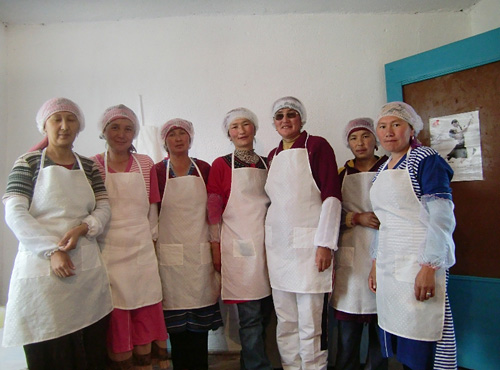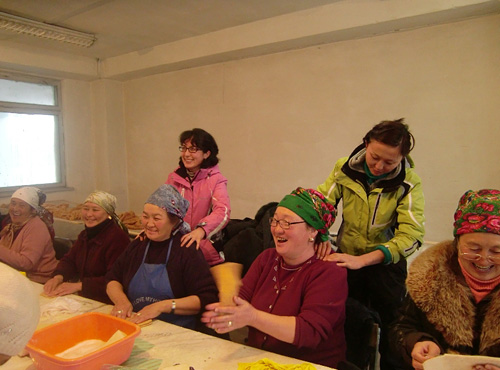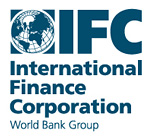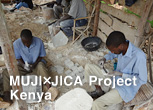#02 Activities in Kyrgyzstan
We revisited Kyrgyzstan this June, following up our visit made last year.
Staying in Kyrgyzstan in June, you feel rich nature on grasslands covered with blooming flowers and a lot of insects, including bees and grasshoppers.
During this visit, we went to some of the communities of our producers near production sites (about 300 producers belong to 35 communities) and had meetings with community leaders to emphasize why quality control is important. After all, manufacturing in developing countries involves problems with quality control and production control. If all people concerned understand these problems and make concerted efforts to solve them, producers in Kyrgyzstan will enhance their production power until they are likely to have opportunities to sell their products not only to us, but also to many people and businesses around the world. The producers can then earn more money to improve their lives. With this aim in mind, they all form producer organizations according to the advice of JICA Kyrgyzstan and our orders, discuss tasks concerning quality and delivery, and gradually build an appropriate framework.
 At the meeting with producers, participants were eager to express their opinions.
At the meeting with producers, participants were eager to express their opinions.
After the meeting with the leaders of producers, all participants went to a hillside for a picnic and ate together. All the people there sang, talked, and had a pleasant time. "Please sing, too," they asked us. After some difficulty in remembering songs we were ready to sing, we managed to sing the "Frog Song" in a round. (We should have some special party performance ready when communicating with people overseas.)
 Commemorative picture of producers and us
Commemorative picture of producers and us
For two days of our stay, we checked the production sites. We advised on management of dangerous objects (such as needles and scissors) and methods for inspecting items. While walking around the production sites, we felt that progress has been achieved compared with what we saw the previous year. Producers proposed their own methods for more efficient production. They already have a framework that enables individual communities to share methods for preparing specification documents concerning all steps from design to production. The production sites are neatly arranged. These facts, which may appear mere trifles, represent great efforts and definitely indicate that all producers treat this felt production as their own business so are making earnest efforts.
The production area is very extensive, as suggested by the fact that the lake is 700 km around. Production control there is extremely difficult, even if ordinary production is assumed. Therefore, we asked the producers and the JICA Kyrgyzstan staff, who are endeavoring to improve production, about their efforts to build a production framework.
The Kyrgyz people were nomadic people, mainly rearing sheep. When Kyrgyzstan became part of the Soviet Union, they developed a textile industry with high-quality merino sheep wool, taking advantage of the cold, mountainous climate. After the Soviet Union collapsed, the industrial structure changed. The production style based on large machinery and communal work collapsed, and the market route for purchasing/selling sheep wool was lost.
Wool produced from merino sheep reared through great efforts was discarded because no customers were found to buy it. Even when wool was collected from small-sized producers, it was difficult to clean the wool all at one time. In addition, since communication among villages was unsatisfactory, it was difficult for local people to cooperate in order to satisfy requests for large-scale production and orders. In this situation, the first-year project managed to achieve its goal last year with the aid of Japan Overseas Cooperation Volunteers. Some changes were required to establish a continued production framework and revitalize the local economy.
The second-year MUJI x JICA project had the specific target of building up the Kyrgyz people's own production and quality monitoring framework.
First, people with relatively high technical skills were chosen from the producer group and appointed as technical leaders. Since Lake Issyk Kul is large, at 700 km around, a technical leader representing each area was also chosen. In addition, people specializing in monitoring, cleaning, and tools were also assigned separately. They said that production activities were not started immediately, but technical training sessions attended by local technical leaders were held repeatedly so that efficient production methods and tools could be developed through trial-and-error processes.
 Identical uniforms started this year, showing good sanitary control. They prevent hair and other foreign matter from entering felt products.
Identical uniforms started this year, showing good sanitary control. They prevent hair and other foreign matter from entering felt products.
 Producers are being instructed about how to measure sizes using a template.
Producers are being instructed about how to measure sizes using a template.
 A local technical leader is carefully checking for size and quality.
A local technical leader is carefully checking for size and quality.
 A technical training session is proceeding till late. Some are joking and some are massaging others' shoulder muscles.
A technical training session is proceeding till late. Some are joking and some are massaging others' shoulder muscles.
In this way, local technical leaders give technical instructions to local producers. That's fine! An efficient production framework has been built up! No, that's not so simple actually, they said. Technical leaders sometimes failed to convey information to producers. Production practices specific to a particular local technical leader were extended to all producers belonging to the same group, with the result that all products were rejected. Such difficulties continued. However, all people did not give up. Monitoring sessions often failed to end on time. The monitoring session for the last group of the day often proceeded till late at night. Both producers and monitors assiduously and carefully discussed problems to solve them till late at night. Sometimes, they argued against each other and some received complaints from their families. With all these efforts, they advanced gradually until the quality of products was improved. It seems that the JICA Kyrgyzstan staff, who support the local sites, feel that it is the first time for local producers to experience the deepening of person-to-person communication and relationships, while continuing such assiduous work. Since people who were not interested in other people or other villages do collaborative work, they may require a number of years to build a reliable local organization. On the other hand, local people think this way: "Given the specific purpose of delivering products that are being processed by hand, we may be happy because we have opportunities to accomplish something in concerted efforts of all local people. Whether these opportunities can be used in any way for Kyrgyzstan to grow is up to Kyrgyz people." We can feel such thinking of the Kyrgyz people when we see a large number of voluntary and creative improvements at production sites.
The MUJI x JICA project with the Kyrgyz people has just started. It is proceeding, supported by the enthusiasm described above.
This column has been written by a MUJI project member with the cooperation of JICA Kyrgyz.



